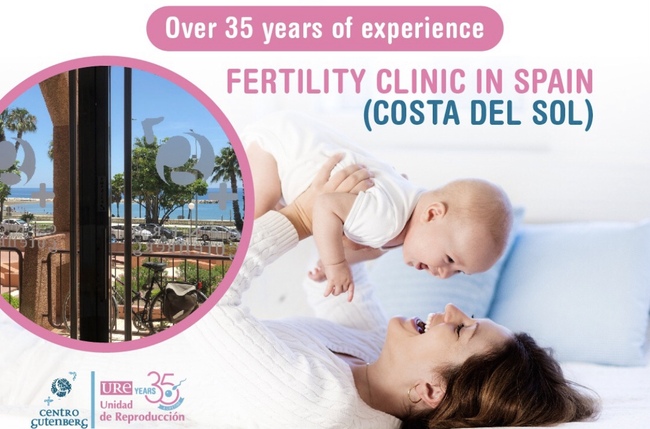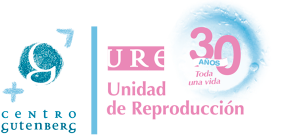URE Centro Gutenberg. Fertility clinic in Spain.

And we could arguably say that we have been growing together for more than 35 years.
URE Centro Gutenberg. Fertility clinic in Spain.
Over 35 years growing by your side in the province of Málaga. It was 1987 when our founder, Dr Martínez Moya, wanted to invest in a brand-new service that did not yet exist in this province. The world’s first test-tube baby was only 9 years old at the time when Dr Martínez Moya proposed that the next one would be ours.
It wasn’t until two years later in 1989, after considerable efforts and attempts made by Dr Martínez Moya and his team led by embryologist Dr Carmen Segura, that the first baby girl born thanks to in vitro fertilisation was born in Malaga, the sixth IVF baby in all of Spain.
Suffice to say that this achievement provided hope for reproductive medicine in Málaga.
We are very proud of our clinic’s feats over the years; we are very proud of everything we have accomplished thanks to the work of our team which has grown strongly and professionally as a result of the trust our patients have placed in us.
We are also extremely pleased to say that we are the parents, and even grandparents, of over 10,000 children born thanks to assisted reproduction techniques. Year after year we have helped make dreams come true for many couples who have put their trust in us, and not only couples from Malaga but also from many parts of the world. We hope to continue bringing you happiness and fulfilled dreams for another 35 years!
What has happened over the last 35 years?
Over the last 35 years we have witnessed and also played a part in the great revolution of reproductive medicine, which has undoubtedly resulted in considerably higher success rates for all assisted reproduction clinics.
We have summarised the most important points here:
- Intracytoplasmic sperm injection (ICSI) revolutionised assisted reproduction techniques as it provided a solution to severe male factor fertility issues. The first microinjector that arrived to Malaga arrived to our clinic.
- The Time-Lapse EmbryoScope. This incubator, when it came out years ago, meant a huge improvement for assisted reproduction laboratories, and we can proudly say that URE Centro Gutenberg was the first laboratory in Malaga to feature one. It is an incubator that makes it possible to observe embryos from the moment they are fertilised until they are removed from their chamber to be transferred to the female’s uterus. This incubator helps us to select the embryo with the greatest implantation potential.
- The technique of freezing through vitrification, which improved egg and embryo survival rates ‑which were formerly less than 50%‑, to over 90% survival post-thawing. We were pioneers of this technique in Malaga. The use of this new technique meant an improvement in cumulative success rates for pregnancy (including the transfer of cryopreserved embryos from the same cycle).
- Preservation of fertility. This has been one of the biggest treatments to revolutionise assisted reproduction over recent years, and in Malaga we were pioneers of this technique. The vitrification of eggs opened the doors to preservation of fertility treatment for women, both for medical and social reasons. Thanks to this treatment, Rocío can now tell us her story: our first mum and first woman from Malaga to become a mother after having cancer. URE Centro Gutenberg was the first clinic in the province of Malaga authorised to utilise this technique.
- Pre-Implantation Genetic Diagnosis (PGD) of embryos has made it possible to improve the prognosis for couples with a history of recurrent miscarriage, for women over the age of 38 and for couples who are carriers of recessive monogenic disorders. At present it is possible to prevent the transmission of many severe genetic illnesses to offspring through the use of PGD and genetic compatibility testing.
- Artificial Intelligence. The latest addition to the laboratory and the first in Malaga. It is an Artificial Intelligence module integrated in our Embryosocope incubator. This system, called «Artificial Intelligence and the KIDScoreD5», analyses and classifies embryos automatically, increasing the possibility of gestation and pregnancy through In Vitro Fertilisation (IVF). This important innovation helps laboratory specialists in reproductive medicine in embryo selection: using a mathematical algorithm, the Artificial Intelligence module helps select the embryo with the best chance of success, which is then transferred to the patient’s uterus.
As an important point, we would like to mention that since 2023, our laboratory has an extra security system. This is the RI-Witness system, a monitoring and traceability system for all biological samples that enter our laboratories. A security system that is currently only available in our Unit in the province of Málaga.
These advances, as well as those that will come in the future, make success rates higher each year for healthy new-borns from IVF. Three decades ago the likelihood of pregnancy through IVF was few and far between, whereas today we can say that success rates are greater than 90%.
A lot has happened since 1987 in that apartment on Calle Gutenberg when Dr Martinez Moya was in control of the wheel. Those of us now in charge of this ship are responsible for continuing to grow our clinic with the dedication, professionalism, empathy and humility that Dr Martinez Moya taught us. The challenge is a difficult one, but when we enjoy what we do and what we were trained to do, everything is easier.
Have you been looking for a pregnancy that just won’t come? Get to know us and discover why we are the clinic you are looking for. Moreover, now, you can do it for free in a first fertility consultation where a specialist doctor will study your situation and indicate which treatment is the most suitable for you.
We are waiting for you!

